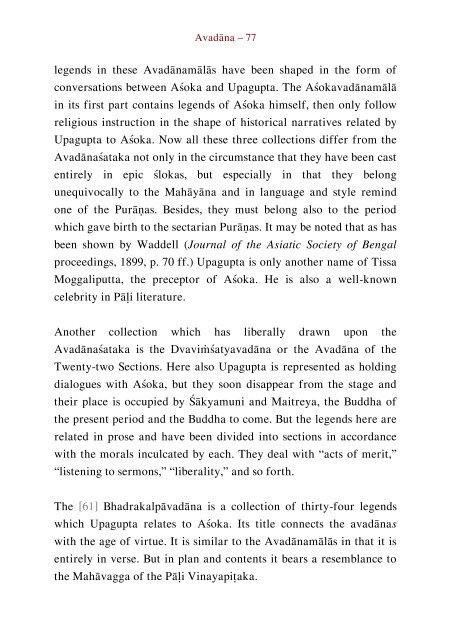Literary History of Sanskrit Buddhism
A study by J. K. Nariman of Sanskrit Buddhism from the Early Buddhist Tradition up to the Mahayana texts proper.
A study by J. K. Nariman of Sanskrit Buddhism from the Early Buddhist Tradition up to the Mahayana texts proper.
You also want an ePaper? Increase the reach of your titles
YUMPU automatically turns print PDFs into web optimized ePapers that Google loves.
Avadāna – 77<br />
legends in these Avadānamālās have been shaped in the form <strong>of</strong><br />
conversations between Aśoka and Upagupta. The Aśokavadānamālā<br />
in its first part contains legends <strong>of</strong> Aśoka himself, then only follow<br />
religious instruction in the shape <strong>of</strong> historical narratives related by<br />
Upagupta to Aśoka. Now all these three collections differ from the<br />
Avadānaśataka not only in the circumstance that they have been cast<br />
entirely in epic ślokas, but especially in that they belong<br />
unequivocally to the Mahāyāna and in language and style remind<br />
one <strong>of</strong> the Purāṇas. Besides, they must belong also to the period<br />
which gave birth to the sectarian Purāṇas. It may be noted that as has<br />
been shown by Waddell (Journal <strong>of</strong> the Asiatic Society <strong>of</strong> Bengal<br />
proceedings, 1899, p. 70 ff.) Upagupta is only another name <strong>of</strong> Tissa<br />
Moggaliputta, the preceptor <strong>of</strong> Aśoka. He is also a well-known<br />
celebrity in Pāḷi literature.<br />
Another collection which has liberally drawn upon the<br />
Avadānaśataka is the Dvaviṁśatyavadāna or the Avadāna <strong>of</strong> the<br />
Twenty-two Sections. Here also Upagupta is represented as holding<br />
dialogues with Aśoka, but they soon disappear from the stage and<br />
their place is occupied by Śākyamuni and Maitreya, the Buddha <strong>of</strong><br />
the present period and the Buddha to come. But the legends here are<br />
related in prose and have been divided into sections in accordance<br />
with the morals inculcated by each. They deal with “acts <strong>of</strong> merit,”<br />
“listening to sermons,” “liberality,” and so forth.<br />
The [61] Bhadrakalpāvadāna is a collection <strong>of</strong> thirty-four legends<br />
which Upagupta relates to Aśoka. Its title connects the avadānas<br />
with the age <strong>of</strong> virtue. It is similar to the Avadānamālās in that it is<br />
entirely in verse. But in plan and contents it bears a resemblance to<br />
the Mahāvagga <strong>of</strong> the Pāḷi Vinayapiṭaka.


















